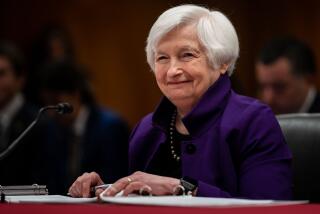Bank Insurance Fund Dips Below Key Level
- Share via
The nation’s Bank Insurance Fund has fallen below its required level for the first time since 1995, regulators said Wednesday, increasing the chance of new fees on banks to replenish the fund, reformation of the deposit-insurance system, or both.
Experts see no widespread problems for banks, however. Although the recession has hurt some institutions, total bank earnings were $21.7 billion in the first quarter this year--the first time quarterly profits exceeded $20 billion.
Despite six bank failures in the first quarter, “the system is in pretty good shape,” and consumers with insured deposits have nothing to fear, said Alexandria, Va., banking consultant Bert Ely.
Still, the decline in Federal Deposit Insurance Corp. reserve ratios, which began three years ago, has bankers, regulators and legislators agreeing that changes to the deposit insurance status quo are inevitable.
The consensus: The FDIC will impose modest new assessments on banks next year, and Congress ultimately will grant the FDIC greater latitude in setting reserve levels and bank premiums. A near certainty, the experts say, is a merger of the Bank Insurance Fund with the Savings Assn. Insurance Fund, which covers savings and loans and is better capitalized.
If the two government funds were merged, their combined insurance reserves would total 1.27% of all deposits, said Kevin Brown, a senior analyst for the FDIC. The minimum ratio presumed healthy under current rules is 1.25%; the bank fund declined to 1.24% in the first quarter.
Although the Bank Insurance Fund grew by $258 million during the quarter, to $30.7 billion, that wasn’t enough to offset the $75-billion increase in insured funds.
In a report on the insurance fund, FDIC Chairman Don Powell said the biggest contributor to declining reserve ratios is a more accurate method of estimating insured deposits at banks. The change, which took effect this year, accounted for two-thirds of the $75-billion increase in insured deposits last quarter.
Ely expects political infighting in Congress, along with more pressing concerns such as homeland security, to delay adoption of a deposit insurance bill beyond the current year. That will leave the FDIC to take steps to ensure the current deficit in reserves doesn’t grow.
James Chessen, chief economist with the American Bankers Assn., said he expects the agency’s list of “troubled” banks, which require separate FDIC reserves, to begin declining later this year. That could free up additional FDIC funds to replenish the insurance fund.
At the most, experts say the FDIC will impose assessments of only 1 or 2 basis points--a penny or two per $100 in deposits--next year, to bring the insurance fund to the required 1.25% level.
“We are talking peanuts” at that level, Ely said. “The banking industry in the early ‘90s was paying 23 basis points a year--for four years.”
Those payments were part of a plan to replenish an insurance system battered by years of heavy losses at commercial banks and savings and loans. By 1996, the bank fund exceeded the 1.25% threshold, a level at which healthy banks no longer were required to pay premiums.
Only 8% of the nation’s banks currently contribute to the fund.
Chessen credited the FDIC for helping troubled institutions resolve their problems through recapitalizations or acquisitions. He said, though, that the FDIC now has too much money--$1.3 billion--set aside for bank failures, and that the nearly $31 billion in the Bank Insurance Fund is more than enough.
Bankers are split on one item in proposed legislation: increasing the deposit insurance amount to $130,000 per account, which would increase the need for FDIC reserves. Large banks--which can raise funds by issuing commercial paper and through brokered accounts--generally oppose higher limits. Community banks, particularly in rural areas, generally support them.
More to Read
Sign up for Essential California
The most important California stories and recommendations in your inbox every morning.
You may occasionally receive promotional content from the Los Angeles Times.














